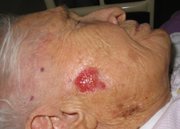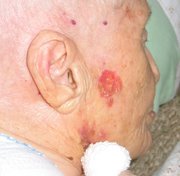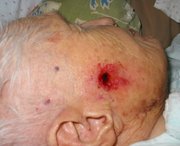Abstract
We describe the imaging findings in a 13-year-old boy with nevoid basal cell carcinoma syndrome (NBCCS). The initial imaging work-up included plain radiographs and computed tomography (CT) of the facial area and mandible. CT detected large expansile cystic changes on both sides of the body and angle of the mandible. When the patient's condition worsened, magnetic resonance imaging (MRI) was performed to farther characterize the nature of the lesions and to rule out intracranial anomalies. We agree with others who have published previous reports that although CT is valuable in elucidating osseous craniofacial anomalies associated with NBCCS, MRI is superior in demonstrating the internal composition and structure of the odontogenic keratocysts that are commonly seen in this syndrome.
Introduction
Nevoid basal cell carcinoma (Gorlin's) syndrome (NBCCS) is an autosomal-dominant disorder that is caused by a mutation of both alleles of the PTCH gene. (1,2) The PTCH gene resides on the long arm of chromosome 9 and codes for the transmembrane receptor protein. (1) In order for dysplastic or neoplastic changes to occur, both alleles must be damaged in the same cell. The incidence of NBCCS is approximately 1 per 60,000 population. (1) The syndrome is characterized by complete penetrance but variable expressivity. As many as one-third of cases occur in patients who do hot have any family history of the syndrome. (2)
The manifestations of NBCCS include multiple basal cell carcinomas, odontogenic keratocysts, palmar and plantar pitting, dural calcifications, craniofacial anomalies, medulloblastomas and other intracranial tumors, ovarian fibromas, and various degrees of mental retardation. (3) Characteristic imaging findings include odontogenic keratocysts of the mandible and maxilla, calcification of the falx cerebri, exaggerated mandible length, macrocephaly, cleft lip and/or palate, large paranasal sinuses, vertebral anomalies (including kyphoscoliosis and abnormal segmentation), rib abnormalities (including fusion or splaying), sclerotic bone lesions, and a short fourth metacarpal bone. (4)
In this article, we describe the imaging findings in a case of NBCCS.
Case report
A 13-year-old boy was brought to our institution with new-onset bilateral oral drainage; the secretion was malodorous and serosanguineous. He also exhibited mandibular enlargement, mild frontal bossing, and hypertelorism. He was afebrile and in no distress. The clinical suspicion of NBCCS was high because of the documented presence of this syndrome in his family; his mother, grandmother, and three uncles all had a history of NBCCS.
The initial imaging work-up included plain radiographs and computed tomography (CT) of the facial area and mandible. CT detected large expansile cystic changes on both sides of the body and angle of the mandible (figure 1). The expansile lesions were clearly intramedullary, and they had caused erosion, thinning, and scalloping of the endosteal cortical bone, although there was no evidence of a periosteal reaction. In general, the cystic lesions were of low density and homogeneous, and there were a few scattered central calcifications within the mandibular cyst on the left side. No associated soft-tissue mass was identified. Additional cysts were seen in the maxillary sinus bilaterally (larger on the left), and there was some bone remodeling. On coronal CT, the largest cyst on the left measured 3 x 2 cm and the largest on the right measured 4 x 2 cm. There were unerupted teeth within the cystic lesions in both the mandible and the maxilla. Intracranially, dural calcifications were noted in the falx cerebri.
[FIGURE 1 OMITTED]
Two days after the CT study, the patient experienced acute tearing, eye pain, and chills, which were followed by a brief loss of consciousness without overt seizure activity. Therefore, magnetic resonance imaging (MRI) was performed to further characterize the nature of the cystic lesions and to rule out intracranial anomalies. Noncontrast T1- and T2-weighted sequences and a contrast-enhanced (intravenous gadolinium) T1-weighted sequence were obtained (figure 2). Multiple expansile cystic lesions were clearly identified bilaterally, and they primarily involved the mandibular ramus. A large lesion on the right with a fluid/fluid level probably represented a hemorrhagic component. Other cystic lesions were present in the maxillary sinus bilaterally (larger on the right), and they were completely occupied by soft tissue/fluid intensity. The cystic lesions were of low signal intensity on the T1-weighted sequence and of high signal intensity on the T2-weighted sequences; there was also some heterogeneous signal intensity, which was probably related to proteinaceous or hemorrhagic components. Some lesions were multiloculated and demonstrated a thin rim enhancement following gadolinium administration.
[FIGURE 2 OMITTED]
MRI of the brain demonstrated minimal thinning of the body of the corpus callosum. The lateral ventricles were slightly enlarged for a patient of this boy's age. No abnormally enhancing brain parenchymal lesion, heterotopic gray matter, or brain tumor was identified.
A plain-film skeletal survey--with emphasis on the scapulae, ribs, hands, and lumbar spine--was performed to search for the bony lesions characteristic of NBCCS. However, the osseous structures appeared to be intact and normal for the patient's age.
The odontogenic keratocysts of the mandible and maxilla were treated with marsupialization, which resulted in some clinical response. The patient is being followed up for possible enucleation of the cysts.
Discussion
Although CT is valuable in elucidating osseous craniofacial anomalies associated with NBCCS, (5) MRI is superior in demonstrating the internal composition and structure of the odontogenic keratocysts that are commonly seen in this syndrome. (6-8) The findings in out patient were in accord with previous radiographic studies of NBCCS. (7,8) CT defined the extent of the patient's cystic lesions and provided detail of the pericystic osseous expansion and wall thinning. Aside from tooth primordia within the cysts, the contents appeared to be homogeneous on CT except for a few calcifications in one mandibular cyst. T2-weighted MRI illustrated the hyperintensity of the lesions, indicating their cystic nature. After administration of contrast material, the cystic lining enhanced on the T1-weighted image. The fluid/fluid level in the right mandibular cyst was consistent with the hemorrhagic component.
The imaging findings in the mandible and maxilla were consistent with odontogenic keratocysts, which are the characteristic lesions of NBCCS. Odontogenic keratocysts are dentigerous or primordial in origin, lined with keratinized epithelium, and more prevalent in the posterior portions of the body and ramus of the mandible. These cysts surround the crown of an unerupted tooth (dentigerous) or tooth-bearing area unassociated with a primordial tooth. (9) The lesions observed in out patient were of the dentigerous variety, because unerupted teeth were visible in both the mandibular and maxillary cysts on CT and MRI.
Our patient was a member of the third generation of his family who had genetically documented NBCCS. The variable expression of NBCCS is dramatically demonstrated in his family tree (figure 3). His mother and grandmother manifested only minimal signs and symptoms, which included hypertelorism, mandibular enlargement, and palmar and plantar pitting. The manifestations in his three uncles were more serious. One uncle experienced multiple recurrent basal cell carcinomas that required frequent surgical removal, another died of adenoid cystic carcinoma of the hard palate, and the third died of ependymoma.
[FIGURE 3 OMITTED]
References
(1.) Gorlin RJ. Nevoid basal cell carcinoma (Gorlin) syndrome: Unanswered issues. J Lab Clin Med 1999;134:551-2.
(2.) Cohen MM, Jr. Nevoid basal cell carcinoma syndrome: Molecular biology and new hypotheses. Int J Oral Maxillofac Surg 1999; 28: 216-23.
(3.) Mirowski GW, Liu AA, Parks ET, Caldemeyer KS. Nevoid basal cell carcinoma syndrome. J Am Acad Dermatol 2000;43:1092-3.
(4.) Taybi H. Lachman RS. Radiology of Syndromes, Metabolic Disorders, and Skeletal Dysplasias. 4th ed. St. Louis: Mosby, 1996:204-5.
(5.) de Kersaint-Gilly A, Hofmann B, Delaire J, et al. A neuroradiological study of the naevoid basal cell carcinoma syndrome. Eighteen cases. J Neuroradiol 1985;12:200-11.
(6.) Lovin JD, Talarico CL, Wegert SL, et al. Gorlin's syndrome with associated odontogenic cysts. Pediatr Radiol 1991;21:584-7.
(7.) Minami M, Kaneda T, Ozawa K, et al. Cystic lesions of the maxillomandibular region: MR imaging distinction of odontogenic keratocysts and ameloblastomas from other cysts. AJR Am J Roentgenol 1996;166:943-9.
(8.) Janse van Rensburg L, Nortje CJ, Thompson I. Correlating imaging and histopathology of an odontogenic keratocyst in the nevoid basal cell carcinoma syndrome. Dentomaxillofac Radiol 1997;26:195-9.
(9.) Sciubba JJ, Fantasia JE, Kahn LB. Tumors and cysts of the jaws. In: Rosai J, Sobin LH, eds. Atlas of Tumor Pathology. Washington, D.C.: Armed Forces Institute of Pathology (fascicle 29), 2001:34-42.
From the Department of Radiology, Louisiana State University Health Sciences Center. New Orleans.
Reprint requests: Enrique Palacios, MD, Department of Radiology, Louisiana State University Health Sciences Center, 1542 Tulane Ave., New Orleans, LA 70131. Phone: (504) 394-0173; fax: (504) 392-2840; e-mail: drpalacios@aol.com
Enrique Palacios, MD Michael Serou, PhD Santiago Restrepo, MD Rafael Rojas, MD
COPYRIGHT 2004 Medquest Communications, LLC
COPYRIGHT 2004 Gale Group




